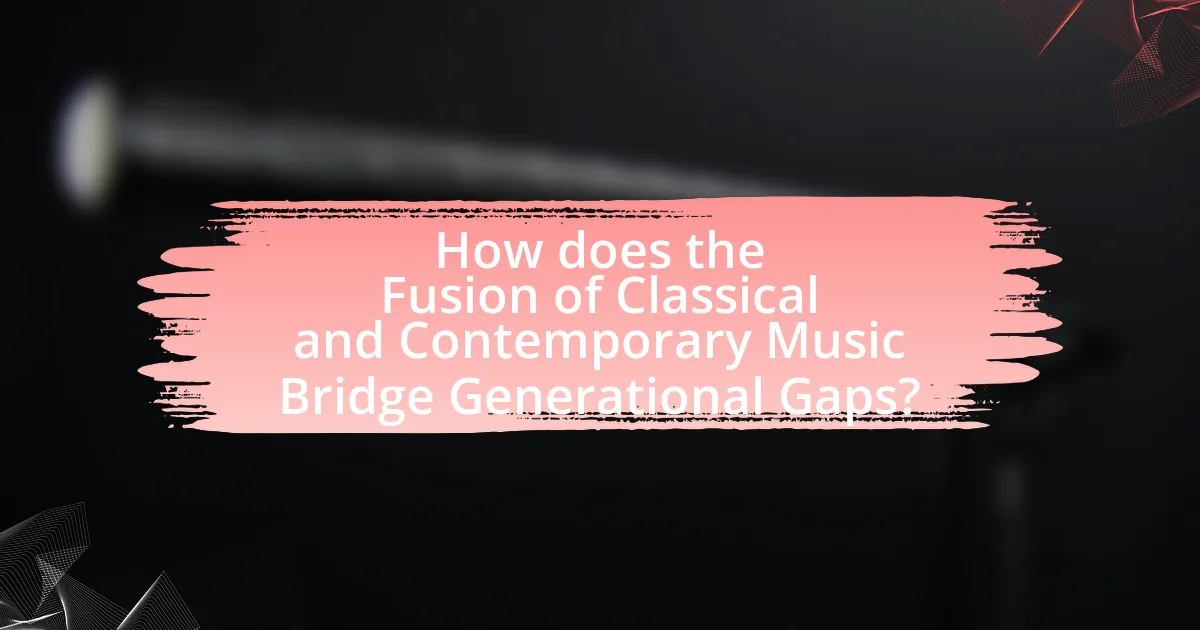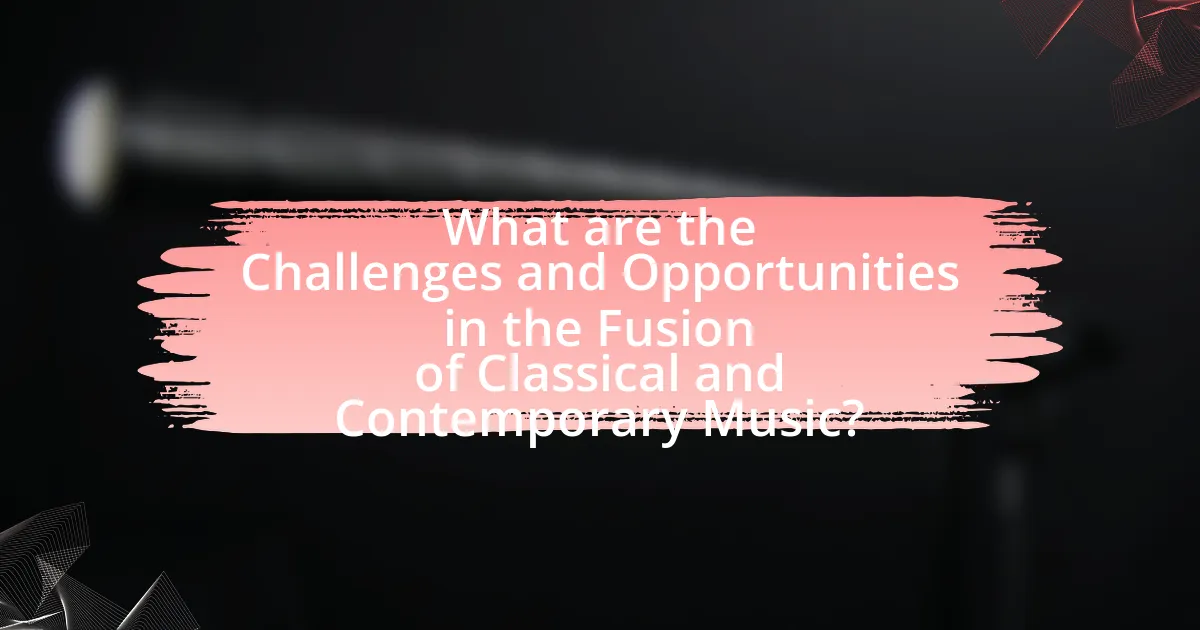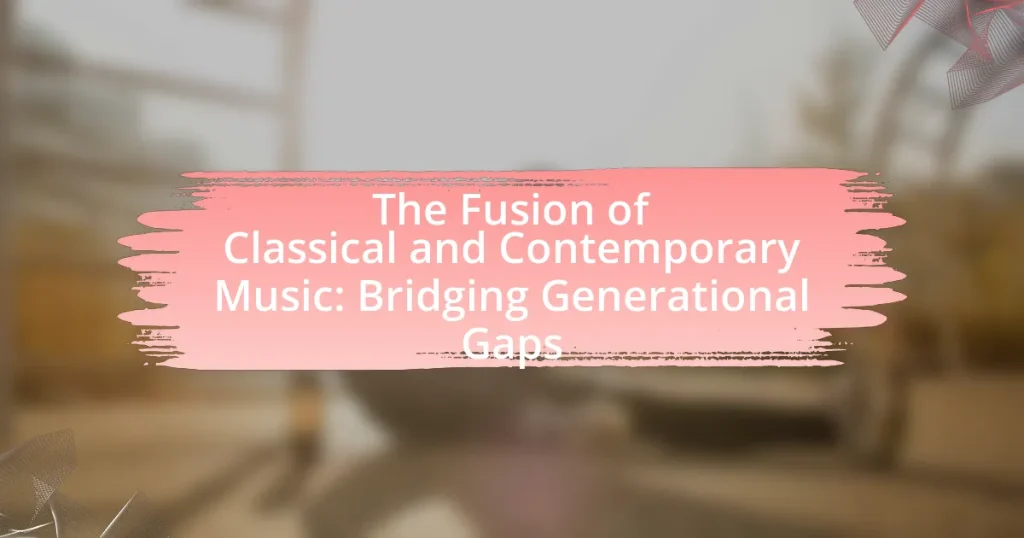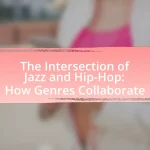The article explores the fusion of classical and contemporary music, highlighting how this blending of traditional and modern elements creates innovative compositions that appeal to diverse audiences. It examines the characteristics of both genres, the significance of their fusion in bridging generational gaps, and the impact on cultural perceptions of music. Key artists such as Max Richter and Yo-Yo Ma are discussed, showcasing successful collaborations that enhance audience engagement. Additionally, the article addresses the challenges and opportunities presented by this fusion, including technical difficulties and innovative techniques that can expand the reach of classical compositions.

What is the Fusion of Classical and Contemporary Music?
The fusion of classical and contemporary music is the blending of traditional classical elements, such as orchestration and harmonic structures, with modern genres like pop, rock, or electronic music. This genre-crossing approach allows for innovative compositions that appeal to diverse audiences, exemplified by artists like Max Richter and Ólafur Arnalds, who incorporate classical instrumentation into contemporary soundscapes. The successful integration of these styles has led to a resurgence of interest in classical music among younger generations, demonstrating its relevance in today’s musical landscape.
How does the fusion of these two genres occur?
The fusion of classical and contemporary music occurs through the blending of traditional elements with modern styles and techniques. This integration often involves the use of classical instruments in contemporary compositions, the incorporation of electronic sounds, and the adaptation of classical motifs into popular music formats. For instance, composers like Max Richter and Ludovico Einaudi have successfully merged orchestral arrangements with minimalist and electronic influences, creating works that appeal to both classical and contemporary audiences. This approach not only revitalizes classical music but also makes it accessible to younger generations, thereby bridging the gap between the two genres.
What are the key characteristics of classical music?
Classical music is characterized by its structured forms, complex harmonies, and emphasis on orchestration. It typically follows specific forms such as sonatas, symphonies, and concertos, which provide a framework for composition. The use of a wide range of dynamics and expressive techniques distinguishes classical music, allowing for emotional depth and nuance. Additionally, classical music often features intricate counterpoint and thematic development, as seen in the works of composers like Bach and Mozart. The historical context of classical music spans from the Baroque period to the Romantic era, showcasing its evolution and influence on contemporary genres.
What defines contemporary music in today’s context?
Contemporary music today is defined by its eclectic blend of genres, innovative use of technology, and emphasis on collaboration among artists. This genre reflects a wide range of influences, including pop, hip-hop, electronic, and classical elements, showcasing a departure from traditional music structures. The integration of digital tools and platforms, such as streaming services and social media, has transformed how music is produced, distributed, and consumed, allowing for greater accessibility and diversity in sound. Additionally, contemporary music often addresses current social issues, resonating with audiences on a personal and cultural level, which is evident in the works of artists like Billie Eilish and Kendrick Lamar, who incorporate relevant themes into their lyrics.
Why is the fusion of classical and contemporary music significant?
The fusion of classical and contemporary music is significant because it creates a bridge between different musical traditions, allowing for innovation and broader audience engagement. This blending enriches the musical landscape by combining the complexity and depth of classical music with the accessibility and modernity of contemporary styles, fostering cross-generational appreciation. For instance, composers like Max Richter and Ludovico Einaudi have successfully integrated classical elements with contemporary genres, resulting in works that resonate with both classical enthusiasts and younger listeners. This fusion not only revitalizes classical music but also encourages new interpretations and collaborations, ultimately expanding the reach and relevance of both genres in today’s diverse musical environment.
How does this fusion impact cultural perceptions of music?
The fusion of classical and contemporary music significantly alters cultural perceptions of music by creating a more inclusive and diverse musical landscape. This blending allows audiences from different generations to appreciate and engage with both genres, fostering a sense of shared cultural identity. For instance, collaborations between classical musicians and contemporary artists, such as the work of Yo-Yo Ma with various pop and hip-hop artists, demonstrate how traditional forms can be revitalized and made relevant to modern listeners. This approach not only broadens the appeal of classical music but also challenges preconceived notions about its exclusivity, thereby reshaping how music is perceived across cultural and generational lines.
What role does innovation play in this musical fusion?
Innovation serves as a catalyst in the fusion of classical and contemporary music by introducing new techniques, instruments, and styles that enhance creative expression. This blending allows artists to reinterpret traditional compositions, making them accessible and relevant to modern audiences. For instance, the incorporation of electronic elements into classical arrangements has led to the emergence of genres like classical crossover, which has gained popularity in recent years, evidenced by artists such as Max Richter and Ólafur Arnalds. Their works demonstrate how innovation can revitalize classical music, bridging generational gaps and attracting diverse listeners.

How does the Fusion of Classical and Contemporary Music Bridge Generational Gaps?
The fusion of classical and contemporary music bridges generational gaps by creating a shared musical language that resonates with diverse age groups. This blending allows younger audiences to appreciate the complexity and emotional depth of classical music while providing a modern context that makes it more accessible. For instance, artists like Yo-Yo Ma have collaborated with contemporary musicians, resulting in projects that attract both classical enthusiasts and new listeners, thereby fostering intergenerational dialogue. Research indicates that such collaborations can increase engagement among younger audiences, as seen in the popularity of crossover genres like classical crossover and orchestral pop, which have gained significant traction in recent years.
What are the generational differences in music preferences?
Generational differences in music preferences are evident in the varying genres and styles favored by different age groups. For instance, younger generations, such as Millennials and Gen Z, tend to prefer pop, hip-hop, and electronic music, often influenced by streaming platforms and social media trends. In contrast, older generations, like Baby Boomers and Generation X, typically favor classic rock, jazz, and traditional pop, reflecting the music that was prevalent during their formative years. Research by the Pew Research Center indicates that 72% of younger adults listen to hip-hop, while only 18% of older adults report the same preference, highlighting a significant divergence in musical tastes across generations.
How do younger audiences perceive classical music?
Younger audiences often perceive classical music as outdated or less relevant to their contemporary lifestyles. This perception is influenced by the dominance of popular music genres in media and social platforms, which shape their musical preferences. Research indicates that only 25% of individuals aged 18-34 actively listen to classical music, highlighting a significant generational divide. However, some younger listeners appreciate classical music when it is integrated with modern genres, such as electronic or hip-hop, suggesting that innovative fusions can enhance its appeal.
What elements of contemporary music attract older generations?
Melodic structures and lyrical themes in contemporary music attract older generations. Many older listeners appreciate melodies that echo traditional forms, as well as lyrics that convey relatable life experiences, nostalgia, and emotional depth. For instance, artists like Adele and Norah Jones incorporate classic songwriting techniques and rich storytelling, which resonate with older audiences familiar with similar elements in classic music. Additionally, the blending of genres, such as jazz, blues, and folk influences in contemporary tracks, creates a familiar sound palette that appeals to older listeners, bridging the gap between their musical preferences and modern styles.
How can fusion music create a shared experience across generations?
Fusion music creates a shared experience across generations by blending diverse musical styles, allowing listeners of different ages to connect through familiar elements. This genre often incorporates traditional melodies and contemporary rhythms, making it accessible and relatable to both older and younger audiences. For instance, artists like Yo-Yo Ma have successfully merged classical music with various genres, such as jazz and world music, which has attracted listeners from different age groups. The combination of these styles fosters a communal atmosphere at performances, where individuals can appreciate the artistry together, thus bridging the generational gap.
What are some successful examples of fusion music that appeal to all ages?
Successful examples of fusion music that appeal to all ages include the works of Yo-Yo Ma, particularly his “Songs of Comfort and Hope” album, which blends classical cello with contemporary genres. Another notable example is the band Pink Martini, whose music combines classical, jazz, and pop elements, attracting a diverse audience. Additionally, the collaboration between the London Symphony Orchestra and contemporary artists like Hans Zimmer showcases how orchestral music can resonate with younger generations while still appealing to classical music enthusiasts. These examples demonstrate the effectiveness of fusion music in bridging generational gaps through diverse musical styles.
How does collaboration between artists from different generations enhance this fusion?
Collaboration between artists from different generations enhances the fusion of classical and contemporary music by combining diverse perspectives and techniques. This intergenerational exchange allows for the blending of traditional elements with modern innovations, resulting in unique soundscapes that appeal to a broader audience. For instance, when a classical musician collaborates with a contemporary artist, they can integrate classical instrumentation with modern rhythms and styles, creating a hybrid genre that retains the richness of classical music while embracing contemporary trends. This approach not only revitalizes classical music but also introduces contemporary artists to the depth of classical traditions, fostering mutual respect and creativity.

What are the Challenges and Opportunities in the Fusion of Classical and Contemporary Music?
The challenges in the fusion of classical and contemporary music include differing audience expectations, stylistic clashes, and the risk of alienating purists from both genres. For instance, classical music often emphasizes structure and tradition, while contemporary music may prioritize innovation and improvisation, leading to potential conflicts in artistic vision. Opportunities arise from the ability to reach broader audiences, create innovative compositions, and foster collaboration among diverse musicians. Successful examples include the works of composers like Max Richter, who blends classical elements with modern electronic music, demonstrating that such fusion can resonate with both classical aficionados and contemporary listeners.
What challenges do artists face when blending these genres?
Artists face several challenges when blending classical and contemporary music genres, primarily due to differing musical structures and audience expectations. The complexity of classical compositions, which often involve intricate arrangements and traditional forms, can clash with the more spontaneous and varied nature of contemporary music, leading to difficulties in creating a cohesive sound. Additionally, artists must navigate the risk of alienating audiences who have strong preferences for one genre over the other, as classical music enthusiasts may resist modern interpretations, while contemporary listeners might find classical elements outdated. Furthermore, technical challenges arise in merging instrumentation and production techniques, as classical music typically relies on acoustic instruments, while contemporary genres often utilize electronic sounds and production methods. These factors collectively complicate the artistic process of fusion, requiring careful consideration and innovative approaches to achieve a successful blend.
How can traditionalists resist the fusion of classical and contemporary music?
Traditionalists can resist the fusion of classical and contemporary music by actively promoting and preserving traditional music forms through education and performance. By organizing workshops, concerts, and educational programs that focus solely on classical music, traditionalists can reinforce its value and significance. Historical evidence shows that dedicated efforts to maintain classical music traditions, such as the establishment of conservatories and classical music festivals, have successfully kept these genres alive and relevant. Additionally, traditionalists can advocate for policies that support classical music funding and programming in schools and public institutions, ensuring that future generations appreciate and engage with classical music rather than contemporary fusions.
What technical difficulties arise in the fusion process?
The technical difficulties that arise in the fusion process of classical and contemporary music include the challenge of blending distinct musical structures and styles. Classical music often relies on complex harmonies and formal compositions, while contemporary music may prioritize rhythm and improvisation. This disparity can lead to clashes in musical language, making it difficult for musicians to create a cohesive sound. Additionally, the integration of different instrumentation and production techniques can complicate the fusion, as classical instruments may not easily adapt to contemporary genres. These challenges necessitate a deep understanding of both musical traditions to achieve a successful synthesis.
What opportunities does this fusion present for musicians and composers?
The fusion of classical and contemporary music presents musicians and composers with opportunities to innovate and reach diverse audiences. This blending allows for the creation of unique soundscapes that can attract listeners from different musical backgrounds, thereby expanding their fan base. Additionally, collaborations between classical and contemporary artists can lead to new compositions that incorporate varied techniques and styles, enhancing artistic expression. Historical examples, such as the works of composers like Leonard Bernstein, who integrated jazz elements into classical frameworks, demonstrate the successful outcomes of such fusions. This approach not only revitalizes classical music but also encourages contemporary musicians to explore and incorporate traditional elements, fostering a richer musical dialogue.
How can fusion music expand the audience for classical compositions?
Fusion music can expand the audience for classical compositions by blending traditional classical elements with contemporary genres, making the music more accessible and appealing to diverse listeners. This approach attracts younger audiences who may find pure classical music less engaging, as seen in successful projects like the collaboration between Yo-Yo Ma and the Silk Road Ensemble, which incorporates various musical traditions. Additionally, fusion music often utilizes modern production techniques and popular styles, enhancing the overall listening experience and drawing in fans from different musical backgrounds. This strategy not only revitalizes classical works but also fosters a greater appreciation for the genre among new audiences.
What innovative techniques can be employed in fusion music creation?
Innovative techniques in fusion music creation include the use of digital technology, cross-genre collaboration, and unconventional instrumentation. Digital technology allows artists to manipulate sounds and create unique textures, as seen in the integration of electronic elements with traditional acoustic instruments. Cross-genre collaboration fosters diverse influences, enabling musicians from different backgrounds to blend styles, exemplified by projects that combine classical orchestration with hip-hop rhythms. Unconventional instrumentation, such as incorporating non-Western instruments into Western music frameworks, expands the sonic palette and creates fresh auditory experiences. These techniques have been successfully employed by artists like Yo-Yo Ma in his Silkroad Ensemble, which merges various cultural sounds, demonstrating the effectiveness of these innovative approaches in bridging generational and cultural gaps in music.
What practical tips can artists follow to successfully fuse classical and contemporary music?
Artists can successfully fuse classical and contemporary music by incorporating elements from both genres in their compositions and performances. To achieve this, artists should study the structures and techniques of classical music, such as harmony and orchestration, while also embracing contemporary styles, rhythms, and technology. Collaborating with musicians from both genres can provide diverse perspectives and innovative ideas, enhancing the fusion process. Additionally, experimenting with instrumentation, such as blending traditional orchestral instruments with electronic sounds, can create unique soundscapes. Historical examples, like the works of composers such as Leonard Bernstein and John Adams, demonstrate successful integration of classical and contemporary elements, showcasing the viability of this fusion approach.


